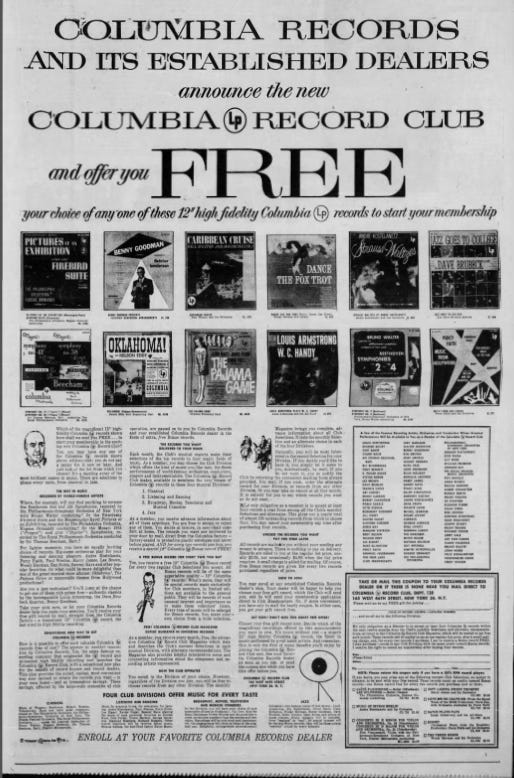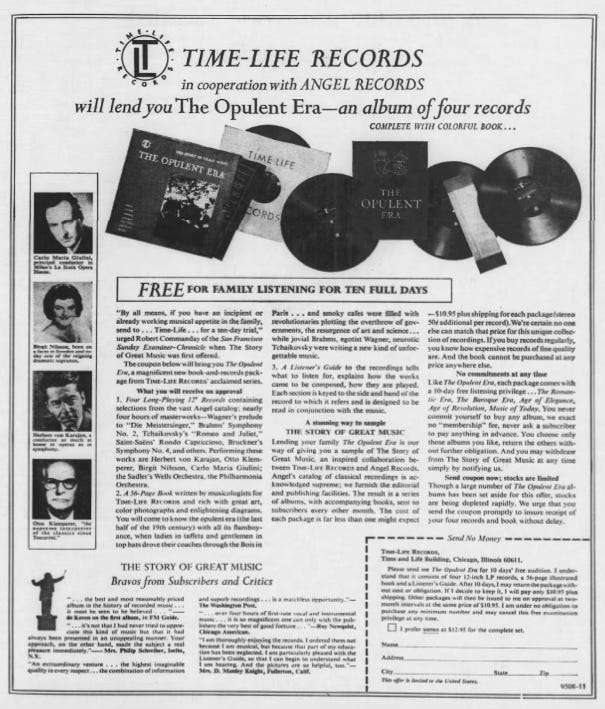The other day, I wrote about my not-so-recent purchase of hundreds of classical albums from an estate sale, which I am slowly working my way through. (And, because life keeps intervening, I mean sloooowly.)
If you read that previous newsletter entry (linked to above), you may recall that the first LPs on the shelf are from a Time-Life Records series covering the history of classical music.
I was interested in finding out how this series came about, which sent me down the rabbit hole of mail-order music, which launched in 1955 with the Columbia Record Club, an experiment in reaching rural listeners who might not have ready access to a record store.
If you are my age or older, you certainly remember the Columbia Record Club’s successor company—Columbia House—which offered a dozen albums for a penny when signing up and was all the rage in the 1970s and ‘80s.
The original Columbia Record Club didn’t offer anything as generous as 12 albums for a cent, just one monophonic LP for free once you signed up. Though the new music of rock and roll was ascendant—Bill Haley and His Comets had the biggest hit of the year in 1955 with “Rock Around the Clock”—there was no rock-and-roll category because Columbia (a division of CBS) didn’t have any rock artists on its roster.1 However, you could choose from “Classical,” “Listening and Dancing,” “Broadway, Movies, Television, and Musical Comedies,” and “Jazz.”
Record shops had great misgivings about the club, which they saw as competition. To assuage their fears, Columbia held releases from the club for six months and, as you can see from this ad, asked people to enroll by visiting their local record shop, presumably to encourage some in-person shopping. (Those rural listeners Columbia was targeting could drop a coupon in the mail for their free LP.)
The experiment was a great success: by the end of 1955, 128,000 people had joined and had purchased 700,000 records. Eventually, cassettes, 8-tracks, and CDs were added to the roster. Columbia House kept going until the early 2000s, when the one-two punch of online retailers like Amazon and the birth of iTunes doomed the company. It was bought in 2002 and limped along until 2008. (An aside: Columbia House became one of the few places where 8-track aficionados could still find music in their preferred format; as late as 1988, the company was still manufacturing albums in that format.)
Time-Life Records, an offshoot of the publishing giant, entered the mail-order business in 1966 with its “Story of Great Music” series, which I’m listening to right now. I couldn’t find any advertising for the initial launch, but here’s a full-page ad from 1967 for the fourth or fifth installment in the series, “The Age of Opulence,” which should be hitting my turntable soon.
Columbia wouldn’t sign any rock stars until Bob Dylan in 1961—then a traditional folk artist—and Dion in 1963.









Thanks a heap, James. Boy, does this take me back to the formative years of my record-collecting mania. Lotsa stuff about the mail-order end that I didn't know!